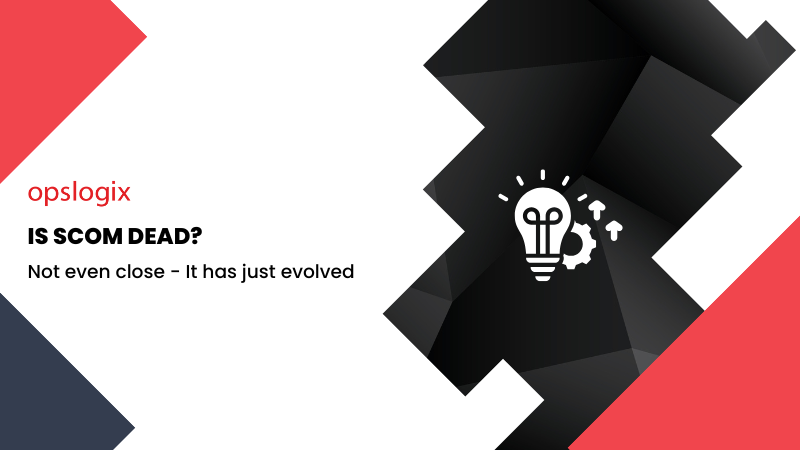Is SCOM dead? Not even close - It has just evolved
by Jonas Lenntun, on May 20, 2025 10:54:17 AM

System Center Operations Manager (SCOM) is far from dead. While a growing number of monitoring alternatives have emerged in recent years, SCOM in 2025 remains a critical tool, especially for organizations running hybrid environments.
Thanks to its stateful, object-oriented monitoring model and a rapidly evolving ecosystem of modern Management Packs (MPs).
Used alongside cloud-native tools like the Grafana LGTM Stack, SCOM adds valuable depth, structure, and context that DevOps teams often miss.
In this blog post, we go through some of the reasons why SCOM remain an essential monitoring solution in 2025.
Why SCOM still matters in 2025
1. Stateful and object-oriented monitoring
Unlike many modern observability tools which are inherently stateless, such as Prometheus, SCOM is designed to track health states of objects over time. It monitors infrastructure components as living objects (services, hosts, applications), and provides a clear view into not just what happened, but also how it impacts your environment.
2. Built-in domain expertise via Management Packs
One of SCOM’s biggest strengths is its extensibility through Management Packs (MPs). These are modular bundles of monitoring logic (discovery rules, monitors, views, and remediation tasks) that encapsulate deep operational knowledge.
Microsoft’s ecosystem of MPs
- Windows Server and Active Directory MPs: Intelligent monitoring beyond basic CPU and memory checks.
- SQL Server MPs: Deep health models, replication tracking, and Always On visibility.
- Exchange, SharePoint, IIS: Prebuilt MPs with tuned alerts and rollup views.
- Azure Stack HCI: Hybrid-aware monitoring that connects cloud and on-prem.
These are maintained by Microsoft’s product teams and reflect years of best practices.
Third-party and custom MPs
SCOM’s community and partners continue to deliver high-quality MPs for technologies not covered by Microsoft. For example, we at Opslogix provide:
- Kubernetes MP: Monitor cluster, pod, node, and container states inside SCOM.
- VMware MP: Deep vSphere visibility including ESXi, datastores, and VMs.
- Oracle MP: Full-featured Oracle DB monitoring for enterprise environments.
Custom MPs can also be developed to support niche applications, giving SCOM nearly unlimited flexibility.
3. Modern integration potential
SCOM is evolving alongside modern observability platforms, thanks to integrations like those from Opslogix:
- SCOM Data Source for Grafana: Expose SCOM objects and metrics in Grafana dashboards.
- SCOM Prometheus Exporter: Feed SCOM data into Prometheus-compatible tools like Mimir or Grafana Cloud.
- SCOM AlertManager MP: Connect to Grafana Alertmanager, retrieve firing alerts from multiple Grafana environments, display them in SCOM, and forward to tools like ServiceNow using the Opslogix ServiceNow Connector.
- Opslogix ServiceNow Connector: Automate ticket creation and alert resolution with bi-directional sync between SCOM and ServiceNow.
- Opslogix SCOM Connector for Microsoft Teams: Send alerts directly into Teams channels for faster, ChatOps-style collaboration.
These integrations empower SCOM to participate in modern incident workflows and cross-platform observability strategies.
SCOM vs Cloud-native observability
Grafana, Prometheus, and OpenTelemetry have become favorites in cloud-native environments. But:
- They are stateless and lack historic context.
- They lack object awareness; everything is a flat metric.
- They often require more manual alert tuning and structure.
SCOM brings structure and operational depth. Grafana brings flexibility and ecosystem scale. Together, they form a complete view across infrastructure and application layers.
Hybrid is here to stay
Most enterprises still run hybrid, and will for the foreseeable future. SCOM excels in this space, especially for Microsoft-heavy environments. And with SCOM Managed Instance (SCOM MI), you can now run SCOM as a Service inside Azure, modernizing without losing control.
Conclusion
Is SCOM dead? Not at all. It is evolving and continues to anchor enterprise monitoring. With integrations into Grafana LGTM and ServiceNow, SCOM brings its traditional strength into modern observability workflows.
If you want structured monitoring and modern observability without compromises, SCOM and Grafana together is the way forward.
We have over 15 years of experience developing solutions for SCOM. Discover our Management Packs, Connectors, Monitoring as a Service and Consultancy Services through the link below.


